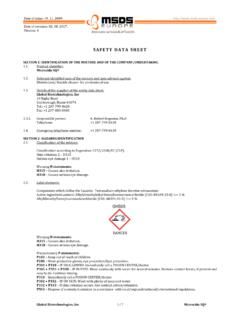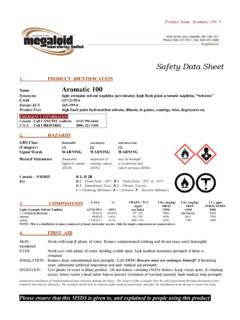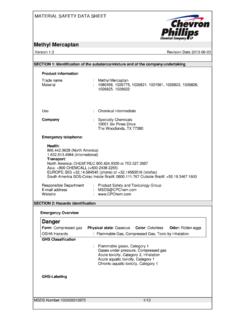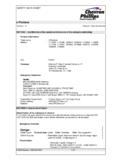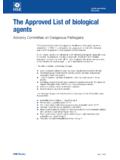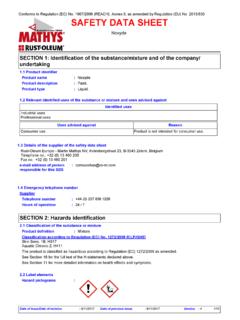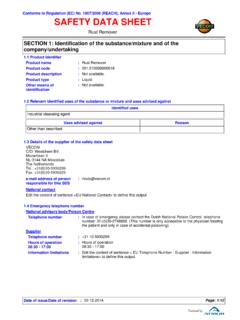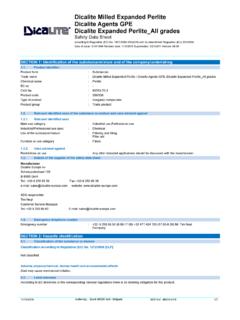Transcription of Material Safety Data Sheet AJAX - Innophos
1 ajax Material Safety data Sheet ajax Date Prepared: 5/27/05 Supersedes Date: 8/13/04 1. PRODUCT AND COMPANY DESCRIPTION Innophos PO Box 8000 259 Prospect Plains Road Cranbury NJ 08512-8000 Emergency Phone Numbers: FOR EMERGENCIES INVOLVING A SPILL, LEAK, FIRE, EXPOSURE OR ACCIDENT CONTACT: CHEMTREC (800-424-9300 within the United States or 703-527-3887 for international collect calls) or Innophos ECT (Emergency Communication Team) at 615-386-7816. For Product Information: (609) 495-2495 Product Status: FDA regulated use only. Chemical Name or Synonym: CALCIUM PHOSPHATE, MONOBASIC, MONOHYDRATE; MCP Molecular Formula: Ca(H2PO4) 2. COMPOSITION/INFORMATION ON INGREDIENTS ComponentCAS Reg NumberOSHA HazardPercentageMONOCALCIUM PHOSPHATE, MONOHYDRATE 10031-30-8 Y 100 file:///P|/Share/MSDS%20 New%20 Site/MSDS%20 New%20 Site/ ajax % (1 of 10)1/8/2009 2:32:06 PMAJAX 3. HAZARDS IDENTIFICATION A. EMERGENCY OVERVIEW: Physical Appearance and Odor: white powder solid, odorless.
2 Warning Statements: CAUTION! MAY CAUSE SKIN AND EYE IRRITATION. B. POTENTIAL HEALTH EFFECTS: Acute Eye: May cause foreign body irritation only. Acute Skin: Skin absorption not likely. May cause slight transient irritation. Acute Inhalation: Dusts may cause upper respiratory tract irritation. Acute Ingestion: Ingestion of large quantities may cause abdominal cramps, nausea, vomiting, diarrhea. Chronic Effects: This product does not contain any ingredient designated by IARC, NTP, ACGIH or OSHA as probable or suspected human carcinogens. 4. FIRST AID MEASURES FIRST AID MEASURES FOR ACCIDENTAL: Eye Exposure: Hold eyelids open and flush with a steady, gentle stream of water for at least 15 minutes. Seek medical attention if irritation develops or persists or if visual changes occur. Skin Exposure: In case of contact, immediately wash with plenty of soap and water for at least 5 minutes. Seek medical attention if irritation developes or persists.
3 Remove contaminated clothing and shoes. Clean contaminated clothing and shoes before re-use. Inhalation: If respiratory irritation or distress occurs remove victim to fresh air. Seek medical attention if respiratory file:///P|/Share/MSDS%20 New%20 Site/MSDS%20 New%20 Site/ ajax % (2 of 10)1/8/2009 2:32:06 PMAJAX irritation or distress continues. Ingestion: If victim is conscious and alert, give 2-3 glasses of water to drink and induce vomiting by touching back of throat with a finger. Do not induce vomiting or give anything by mouth to an unconscious person. Seek immediate medical attention. Do not leave victim unattended. Vomiting may occur spontaneously. To prevent aspiration of swallowed product, lay victim on side with head lower than waist. If vomiting occurs and the victim is conscious, give water to further dilute the chemical. MEDICAL CONDITIONS POSSIBLY AGGRAVATED BY EXPOSURE: Inhalation of product may aggravate existing chronic respiratory problems such as asthma, emphysema or bronchitis.
4 Skin contact may aggravate existing skin disease. NOTES TO PHYSICIAN: All treatments should be based on observed signs and symptoms of distress in the patient. Consideration should be given to the possibility that overexposure to materials other than this product may have occurred. 5. FIRE FIGHTING MEASURES FIRE HAZARD data : Flash Point: Not Applicable Extinguishing Media: Not combustible. Use extinguishing method suitable for surrounding fire. Special Fire Fighting Procedures: Firefighters should wear NIOSH/MSHA approved self-contained breathing apparatus and full protective clothing. Dike area to prevent runoff and contamination of water sources. Dispose of fire control water later. Unusual Fire and Explosion Hazards: Not combustible. Hazardous Decomposition Materials (Under Fire Conditions): none known 6. ACCIDENTAL RELEASE MEASURES Evacuation Procedures and Safety : file:///P|/Share/MSDS%20 New%20 Site/MSDS%20 New%20 Site/ ajax % (3 of 10)1/8/2009 2:32:06 PMAJAXWear appropriate protective gear for the situation.
5 See Personal Protection information in Section 8. Containment of Spill: Dike or retain dilution water or water from firefighting for later disposal. Follow procedure described below under Cleanup and Disposal of Spill. Cleanup and Disposal of Spill: Sweep or vacuum up and place in an appropriate closed container (see Section 7: Handling and Storage). Clean up residual Material by washing area with water and detergent. DO NOT RETURN Material TO ITS ORIGINAL CONTAINER. Environmental and Regulatory Reporting: Runoff from fire control or dilution water may cause pollution. Spills may be reportable to the National Response Center (800-424-8802) and to state and/or local agencies. 7. HANDLING AND STORAGE Minimum/Maximum Storage Temperatures: Not Available Handling: This is a food ingredient intended for human consumption. Keep containers closed when not being used. Avoid contamination of storage containers. Storage: Store in an area that is cool, dry, sanitary, Store in closed containers.
6 This product is hygroscopic and tends to cake on storage. Expected shelf life if stored at recommended temperatures: 2 years. 8. EXPOSURE CONTROLS/PERSONAL PROTECTION Introductory Remarks: These recommendations provide general guidance for handling this product. Because specific work environments and Material handling practices vary, Safety procedures should be developed for each intended application. While developing safe handling procedures, do not overlook the need to clean equipment and piping systems for maintenance and repairs. Waste resulting from these procedures should be handled in accordance with Section 13: Disposal Considerations. Assistance with selection, use and maintenance of worker protection equipment is generally available from equipment manufacturers. Exposure Guidelines: Exposure limits represent regulated or recommended worker breathing zone concentrations measured file:///P|/Share/MSDS%20 New%20 Site/MSDS%20 New%20 Site/ ajax % (4 of 10)1/8/2009 2:32:06 PMAJAXby validated sampling and analytical methods, meeting the regulatory requirements.
7 The following limits apply to this Material , where, if indicated, S=skin and C=ceiling limit: PARTICULATES NOT OTHERWISE REGULATED RESPIRABLE FRACTION Notes TWASTELOSHA 5 mg/cu m PARTICULATES NOT OTHERWISE REGULATED TOTAL DUST Notes TWASTELOSHA 15 mg/cu m Engineering Controls: Where engineering controls are indicated by use conditions or a potential for excessive exposure exists, the following traditional exposure control techniques may be used to effectively minimize employee exposures. Respiratory Protection: When respirators are required, select NIOSH/MSHA approved equipment based on actual or potential airborne concentrations and in accordance with the appropriate regulatory standards and/or industrial recommendations. Eye/Face Protection: Eye and face protection requirements will vary dependent upon work environment conditions and Material handling practices. Appropriate ANSI Z87 approved equipment should be selected for the particular use intended for this Material .
8 It is generally regarded as good practice to wear a minimum of Safety glasses with side shields when working in industrial environments. Skin Protection: Skin contact should be minimized through use of gloves and suitable long-sleeved clothing ( , shirts and pants). Consideration must be given both to durability as well as permeation resistance. Work Practice Controls: Personal hygiene is an important work practice exposure control measure and the following general measures should be taken when working with or handling this Material : (1) Do not store, use, and/or consume foods, beverages, tobacco products, or cosmetics in areas where this Material is stored. (2) Wash hands and face carefully before eating, drinking, using tobacco, applying cosmetics, or using the toilet. (3) Wash exposed skin promptly to remove accidental splashes or contact with this Material . 9. PHYSICAL AND CHEMICAL PROPERTIES file:///P|/Share/MSDS%20 New%20 Site/MSDS%20 New%20 Site/ ajax % (5 of 10)1/8/2009 2:32:06 PMAJAX Physical and Chemical properties here represent typical properties of this product.
9 Contact the business area using the Product Information phone number in Section 1 for its exact specifications. Physical Appearance: white powder solid. Odor: odorless. pH: at 1 wt/wt%. Specific Gravity: Not Available Density: to g/ml at 25 C (77 F). Water Solubility: slightly soluble Melting Point Range: Not Available Boiling Point Range: Not Available Vapor Pressure: Not Available Vapor Density: Not Available Molecular Weight: 10. STABILITY AND REACTIVITY Chemical Stability: This Material is stable under normal handling and storage conditions described in Section 7. Conditions To Be Avoided: none known file:///P|/Share/MSDS%20 New%20 Site/MSDS%20 New%20 Site/ ajax % (6 of 10)1/8/2009 2:32:06 PMAJAXM aterials/Chemicals To Be Avoided: none known Decomposition Temperature Range: 200 C (392 F) The Following Hazardous Decomposition Products Might Be Expected: Decomposition Type: thermal none known Hazardous Polymerization Will Not Occur.
10 Avoid The Following To Inhibit Hazardous Polymerization: not applicable 11. TOXICOLOGICAL INFORMATION Acute Eye Irritation: Toxicological Information and Interpretation: eye - eye irritation, rabbit. Moderately irritating. Unwashed. Non-irritating. Washed. Acute Skin Irritation: Toxicological Information and Interpretation: skin - skin irritation, rabbit. Non-irritating. (At 4 hours.). Acute Dermal Toxicity: No test data found for product. Acute Respiratory Irritation: No test data found for product. Acute Inhalation Toxicity: No test data found for product. Acute Oral Toxicity: Toxicological Information and Interpretation: LD50 - lethal dose 50% of test species, 17500 mg/kg, rat. Chronic Toxicity: This product does not contain any substances that are considered by OSHA, NTP, IARC or ACGIH to be "probable" or "suspected" human carcinogens. file:///P|/Share/MSDS%20 New%20 Site/MSDS%20 New%20 Site/ ajax % (7 of 10)1/8/2009 2:32:06 PMAJAX 12.
